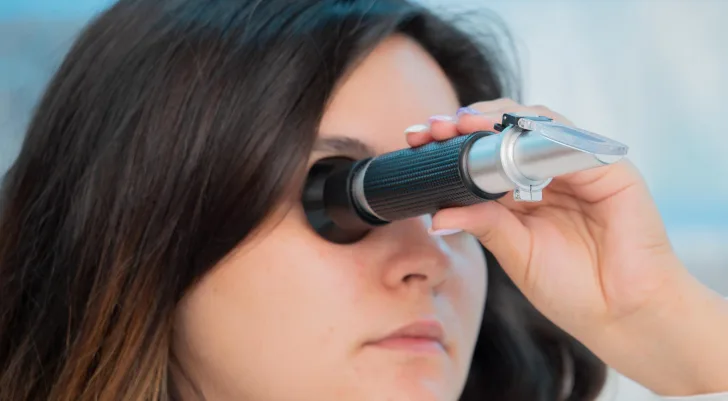
Refractometers are ubiquitously used in veterinary clinics to provide rapid, easy, inexpensive assessment of protein concentration in plasma and other fluids. Refraction of light in an aqueous solution is proportional to the concentration of solids in that solution.1 Most solids in plasma are proteins; therefore, the degree of light refraction is predominantly dependent on protein concentration.1 Although most refractometer scales are calibrated for protein assessment, nonprotein substances can contribute to the angle of refraction and may therefore interfere with results when present in increased concentrations.1,2
Provided here are the authors’ top clinical considerations regarding refractometric interference when measuring plasma total protein.
1. Lack of Interference of Hemolysis & Icterus
Hemolysis results in pink or red plasma due to the presence of free hemoglobin (Figure 1).

Hemolytic serum
Icterus results in yellow plasma due to the presence of increased bilirubin.
Both hemoglobin and bilirubin are commonly thought to cause falsely increased plasma protein values. Although significant plasma pigmentation may cause interference by making reading the dividing line of the refractometer scale more difficult, studies show neither hemoglobin nor bilirubin cause an actual false increase in plasma protein values when measured via refractometer.1,3-5
2. Lipemia & Hypercholesterolemia
Lipemia is caused by the presence of large, triglyceride-rich lipoprotein particles (ie, chylomicrons, very-low-density lipoproteins) that result in the characteristic milky appearance of the sample with increased turbidity and opacity (Figure 2).1,6

Lipemic whole blood from an unfasted dog. This sample was refrigerated overnight, allowing the RBCs to settle and thereby accentuate the lipemic nature of the plasma (arrow).
The presence of increased triglycerides causing lipemia may be due to underlying pathologic mechanisms, but lipemia is most commonly a postprandial artifactual change in unfasted patients.6 Lipemia increases the turbidity of serum and/or plasma, resulting in light refraction disturbances that cause a false increase in refractometric plasma protein.1,6
The simplest way to avoid errors related to lipemia is to require patient fasting for 8 to 12 hours prior to appointments and planned blood collections.6 If fasting is not an option (eg, in emergency cases), refractometric protein concentration, as well as other CBC (eg, hemoglobin, mean corpuscular hemoglobin concentration, mean corpuscular hemoglobin) and serum chemistry values (eg, method-dependent pseudohyponatremia and hypochloremia), may be erroneous as a result of the lipemic sample. Lipid-clearing agents are available but may significantly increase imprecision.7
Cholesterol is an important component of lipoproteins.8 Unlike triglyceride-rich lipoproteins (ie, chylomicrons, very-low-density lipoproteins), cholesterol-rich lipoproteins (ie, low-density lipoproteins, high-density lipoproteins) do not cause plasma opacity. An increased cholesterol concentration thus does not result in gross lipemia but does interfere with the refractive index of a sample.8 One study found that an increase in serum cholesterol of 38.6 mg/dL (1 mmol/L) was associated with an average independent increase in refractometer total plasma protein of 0.14 g/dL (1.36 g/L)(P <0.001, 95% confidence interval = 1.12-1.59).8
3. Short Sample/Excess EDTA
Underfilling an EDTA blood-collection tube (Figure 3) results in an inappropriately high concentration of anticoagulant compared with the amount of blood. EDTA compounds (eg, dipotassium, tripotassium) contribute to plasma total solids and can thus cause significant overestimation of plasma protein at high concentrations.9 The magnitude of EDTA effect depends on sample volume disparity.

EDTA tube that contains an insufficient amount of blood for the tube size. A subtle fill line is visible (arrow).
4. Hyperglycemia
Hyperglycemia is common and can occur as a result of increased glucose uptake (ie, dietary, intravenous), increased glucose production by the liver (ie, gluconeogenesis), increased breakdown of stored glycogen in the liver (ie, glycogenolysis), and/or decreased insulin uptake by tissue (ie, insulin deficiency or resistance).1 Hyperglycemia can cause falsely increased refractometric plasma protein measurements regardless of the mechanism.1,8 One study found that an increase in serum glucose of 180 mg/dL (10 mmol/L) was associated with an average increase in refractometric total plasma protein concentration of 0.23 g/dL (2.27 g/L)(P <0.001, 95% confidence interval = 1.08-3.47).8 Another report indicated that a plasma glucose concentration of ≈700 mg/dL (38.9 mmol/L) results in a false increase in refractometric plasma protein reading of 0.6 g/dL (6 g/L).1
5. Increased Urea Nitrogen
Azotemia in cats and dogs is common and can be due to prerenal, renal, or postrenal causes. A prospective study of azotemic and nonazotemic cats and dogs found that increased concentrations of urea nitrogen significantly increased the total protein concentration measured by refractometer regardless of the mechanism of azotemia.2 Another study reported that the total protein reading is falsely increased by 0.6 g/dL if the plasma urea concentration is ≈300 mg/dL (107 mmol/L).1
Conclusion
Hemoglobinemia and icterus do not cause falsely increased plasma protein when measured by refractometry; however, either substance can make the refractometer scale more difficult to read.1,3-5 Excessive amounts of EDTA (due to a short sample), lipemia, hypercholesterolemia, hyperglycemia, and azotemia can interfere with refractive index values and thus falsely increase the refractometric plasma protein reading.1,2,6,8,9